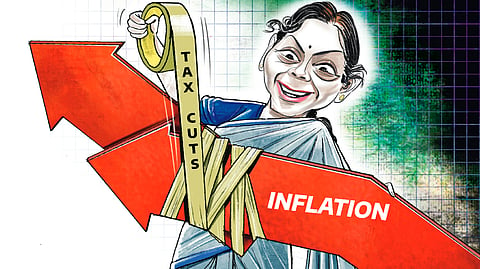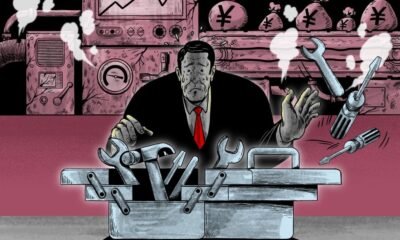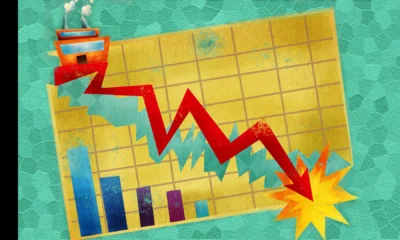Opinion
The Middle Class Conundrum. Will Budget 2025 Solve It? Highly Unlikely. Here’s Why.
With Budget 2025 on the horizon, hopes are pinned on the government to offer some relief. But will it deliver?
With Budget 2025 on the horizon, hopes are pinned on the government to offer some relief. But will it deliver?
Published
9 months agoon

Finance Minister Nirmala Sitharaman is just a few weeks away for tabling Budget 2025 and there is a growing anticipation amongst the middle class regarding the announcement of policies and measures by the government to curb inflation, increase purchasing power and ease financial burden.
India’s middle class, is often referred to as the backbone of the nation’s economy, but this segment has been facing multiple challenges. Rising prices, stagnant wages, and a declining sense of financial security have pushed this segment into a precarious position. With Budget 2025 on the horizon, hopes are pinned on the government to offer some relief. But will it deliver?
1) A Shrinking Wallet and Rising Costs
Over the years, India’s middle class has driven consumption, from retail goods to real estate. However, the scenario today is sharply different. People are buying less, not because they want to, but because they can’t afford to. Prices of essential goods and services have surged, and incomes haven’t kept pace. Disposable income, the lifeblood of consumption, has dwindled.
Therefore, can Budget 2025 provide relief by cutting income tax and leaving more money in the hands of consumers? The answer is complicated.
2) The Tax Cut Dilemma
Theoretically, reducing income tax rates could boost consumption. More disposable income in the hands of consumers should, in theory, lead to increased spending. However, this is where the challenges begin –
Welfare Schemes Need Funding: If the government cuts taxes, it will face a revenue shortfall. To fund essential welfare schemes targeting the poor, the government will need to find alternative revenue sources or borrow more. Given the current fiscal constraints, either choice has significant repercussions.
The Fiscal Deficit Conundrum: Increasing the fiscal deficit to compensate for reduced tax revenue could invite downgrades from global rating agencies. Such downgrades raise India’s country risk, deterring foreign institutional investors (FIIs). The withdrawal of FIIs from Indian markets would put downward pressure on the rupee, leading to further economic instability.
3) The Domino Effect of a Weak Rupee
A weakened rupee has far-reaching consequences. As the currency depreciates, the cost of imports—especially crude oil—rises. India, being heavily reliant on oil imports, would see fuel prices surge.
This would either:
In either case, the economic pressure on the middle class intensifies.
4) Interest Rates and Their Impact
To finance a larger deficit, the government would need to issue more bonds. An increased supply of government bonds would drive down bond prices, raising yields. Higher yields mean higher interest rates, which have two key effects –
–Investment and Consumption Decline: Elevated borrowing costs discourage businesses from investing and consumers from taking loans. Whether it’s a home loan, car loan, or personal loan, higher interest rates deter spending, nullifying any gains from lower income tax rates.
–Savings Over Spending: Higher interest rates also encourage the affluent to save rather than spend. This behavioral shift would nullify the intended purpose of tax cuts, which is to stimulate demand.
5) Corporate Challenges and Job Losses
The middle class’s woes don’t end with macroeconomic factors. Corporates, already struggling with falling profit margins, are likely to reduce wage costs further. This could lead to job cuts, raising unemployment and shrinking the middle class’s purchasing power.
Therefore, in essence, any relief provided by income tax cuts would be short-lived, as broader economic pressures take center stage.

Several Areas Where the Middle-Class Household May Benefit
Despite the challenges, there are areas where the middle class might see some relief in Budget 2025 –
Caught in the Global Financial Web
The inherent contradiction lies in India’s immersion in the global regime of finance capital. Fiscal discipline, a requirement for favorable global ratings and investor confidence, often conflicts with the domestic need for economic stimulus. As a result, the middle class finds itself trapped in a vicious cycle of “Heads they win, tails you lose.”
)
What Can Be Done?
While cutting taxes may provide temporary relief, a sustainable solution requires addressing the structural challenges faced by the middle class.
Some potential measures include –
Boosting Wage Growth: Policies that encourage wage increases in both public and private sectors could help restore purchasing power.
Targeted Subsidies: Direct subsidies on essential goods and services can ease the burden of rising prices.
Investment in Job Creation: Government spending on infrastructure and manufacturing can generate employment, providing a steady income stream for households.
Addressing Inflation: Tackling inflation through better supply chain management and reducing dependency on imports can stabilize household budgets.
The Last Bit


China To Cut Inflation Outlook To 20-Year Low, Eyes Fresh Stimulus At ‘Two Sessions’ To Boost Economy


Trump’s Latest Tariff Move on Mexico and Canada. Import Taxes Back on Track Hinting At A Full Blown Trade War!


The Slippery Slope Of One More Drop. Nifty Nearing Its 28-Year Record-Breaking Crash. Is Zomato And Jio Fin To Be Blamed?


Indian Stock Markets’ Downward Spiral Continues, Sensex Down 3,000 Points In Over A Week! The Big Guns Lose Rs 81,000 Crore—Will The Mayhem Stop?


Global Economic Pulse, UK’s Surprise Growth, US Inflation Jumps While China And Japan Battle It Out—Who’s Leading And Who’s Lagging?


All About The Union Budget 2025-26—Worthy of Claps, Or Is There Something Lurking That We May Have Missed?
